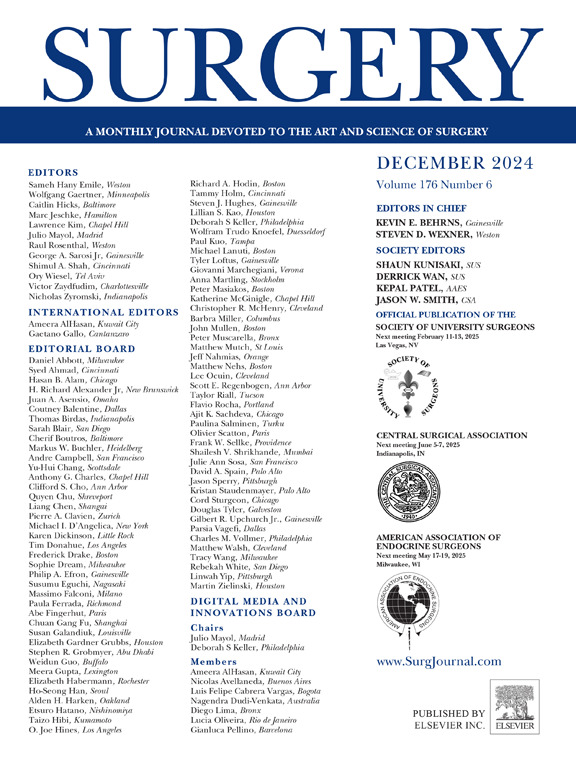结直肠癌术后姑息治疗使用的时间趋势和地区差异
IF 2.7
2区 医学
Q1 SURGERY
引用次数: 0
摘要
背景姑息治疗可以提高患者满意度,减少疼痛,降低成本,但在结直肠手术中的应用相对不足。我们对接受手术的结直肠癌患者进行了特征描述,假设姑息治疗使用的区域和时间差异。方法选取2016-2021年全国住院患者样本中接受结肠切除术、直肠切除术或造口术的结直肠癌患者。该队列被分为选择性和非选择性亚组。主要研究终点是姑息治疗使用的趋势和地区差异。我们开发了多变量回归模型,以确定姑息治疗与住院时间和费用之间的独立关联。结果599,275例接受结直肠癌手术的成年患者中,2.5%接受了姑息治疗。从2016年到2021年,PC的使用增加了(2.1% vs 2.8%, nptrend <0.001)。东北部的患者接受姑息治疗的频率较低。在选择性队列中,更大的合并症负担(Elixhauser:校正优势比,1.10 /单位;95%可信区间,1.05-1.16)与接受姑息治疗的可能性更大相关。少数族裔(黑人:调整优势比为0.78,95%可信区间为0.67-0.91;西班牙裔:调整优势比为0.78,95%可信区间为0.66-0.92;亚洲/太平洋岛民调整优势比为0.76,95%可信区间为0.58-0.98)和农村(调整优势比为0.54,95%可信区间为0.44-0.65)或城市非教学中心(调整优势比为0.74,95%可信区间为0.66-0.82)的护理与非选择性队列中姑息治疗的几率降低相关。接受姑息治疗的患者LOS (β+ 3.82天,95%可信区间,3.41-4.23)和住院费用(β+ 12,000美元,95%可信区间,10,000-13,000美元)增加。结论结直肠癌术后姑息治疗随着时间的推移而增加,但仍不常见。少数民族和地理区域仍然与减少使用有关。需要更好地描述影响姑息治疗使用和结果的因素。本文章由计算机程序翻译,如有差异,请以英文原文为准。

Temporal trends and regional variation in the use of palliative care after colorectal cancer surgery
Background
Palliative care can improve patient satisfaction, decrease pain, and reduce costs but is relatively underused in colorectal surgery. We characterized patients with colorectal cancer undergoing surgery, hypothesizing regional and temporal differences in palliative care use.
Methods
Patients with colorectal cancer undergoing colon resection, rectal resection, or ostomy formation were identified in the 2016–2021 National Inpatient Sample. The cohort was divided into elective and nonelective subgroups. The primary study end points were trends and regional differences in palliative care use. Multivariable regression models were developed to identify the independent association of palliative care with length of stay and costs.
Results
Of 599,275 adult patients undergoing surgery for colorectal cancer, 2.5% received palliative care. From 2016 to 2021, use of PC increased (2.1 vs 2.8%, nptrend <0.001). Patients in the Northeast less frequently received palliative care. A greater burden of comorbidities (Elixhauser: adjusted odds ratio, 1.10 per unit; 95% confidence interval, 1.05–1.16) was associated with a greater likelihood of receipt of palliative care in the elective cohort. Minority race (Black: adjusted odds ratio; 0.78, 95% confidence interval, 0.67–0.91; Hispanic: adjusted odds ratio, 0.78; 95% confidence interval, 0.66–0.92; Asian/Pacific Islander adjusted odds ratio, 0.76; 95% confidence interval, 0.58–0.98) and care at rural (adjusted odds ratio, 0.54; 95% confidence interval, 0.44–0.65) or urban non-teaching centers (adjusted odds ratio, 0.74; 95% confidence interval, 0.66–0.82) were associated with reduced odds of palliative care in the nonelective cohort. Patients receiving palliative care had increased LOS (β + 3.82 days, 95% confidence interval, 3.41–4.23) and hospitalization costs (β+$12,000, 95% confidence interval, $10,000–13,000).
Conclusions
Palliative care after surgery for colorectal cancer has increased over time but remains infrequent. Minority race and geographic region remain associated with reduced use. Better characterization of factors influencing palliative care use and outcomes is needed.
求助全文
通过发布文献求助,成功后即可免费获取论文全文。
去求助
来源期刊

Surgery
医学-外科
CiteScore
5.40
自引率
5.30%
发文量
687
审稿时长
64 days
期刊介绍:
For 66 years, Surgery has published practical, authoritative information about procedures, clinical advances, and major trends shaping general surgery. Each issue features original scientific contributions and clinical reports. Peer-reviewed articles cover topics in oncology, trauma, gastrointestinal, vascular, and transplantation surgery. The journal also publishes papers from the meetings of its sponsoring societies, the Society of University Surgeons, the Central Surgical Association, and the American Association of Endocrine Surgeons.
 求助内容:
求助内容: 应助结果提醒方式:
应助结果提醒方式:


